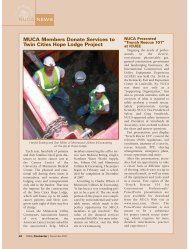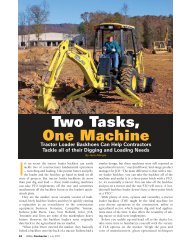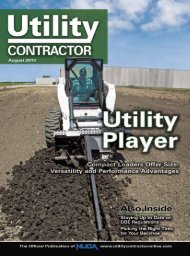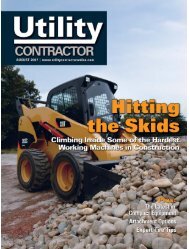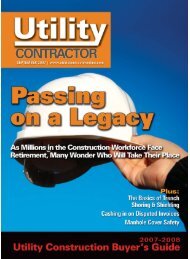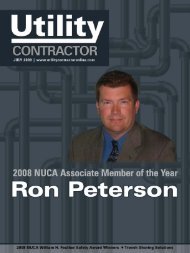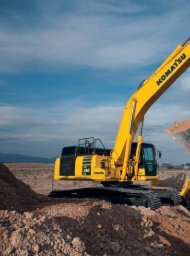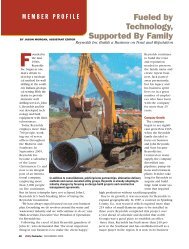View Full December PDF Issue - Utility Contractor Online
View Full December PDF Issue - Utility Contractor Online
View Full December PDF Issue - Utility Contractor Online
You also want an ePaper? Increase the reach of your titles
YUMPU automatically turns print PDFs into web optimized ePapers that Google loves.
safety management<br />
the equipment should be off when performing such a demo.<br />
For a basic understanding of what should be considered,<br />
visit this website: www.dmp.wa.gov.au/documents/Pamphlets/<br />
MSH_P_WorkingNearLargeMobileEquipment.pdf.<br />
Backing Up<br />
To warn other workers when a vehicle is in reverse, OSHA<br />
requires operational backup alarms or a spotter. According<br />
to the North Carolina Department of Labor, even if a vehicle<br />
is equipped with backup alarms, the best way to prevent vehicles<br />
from backing over employees is to have a spotter. With<br />
so many alarms on jobsites, employees start to ignore them.<br />
An assigned spotter must understand that a spotter’s main responsibility<br />
is to look out for him or herself and everyone in<br />
the area. The spotter should be instructed to never leave the<br />
driver’s sight without notifying the operator to stop and should<br />
establish consistent hand signals with the operator, signaling<br />
from an area where the driver can see the spotter. Operators<br />
should also be instructed to stop the vehicle or equipment if<br />
they lose sight of the spotter. Operators should inspect their<br />
vehicles/equipment regularly to ensure that:<br />
• Backup alarms and horns are working,<br />
• Rear-view mirrors are not broken and are properly adjusted,<br />
• Brakes are working, and<br />
• All glass surrounding the cab is clean and not broken.<br />
As we move into the future, more vehicles and machinery<br />
will be equipped or retrofitted with backup sensors and<br />
rearview wireless cameras. Some excavators are equipped<br />
with swing/motion alarms, a relatively new feature. While not<br />
required by OSHA, they are a good idea and can be retrofitted<br />
to older equipment. Some issues still need to be worked out<br />
and changes are occurring every day. OSHA is currently considering<br />
whether to require such devices. More information<br />
about sensors and cameras can be found by searching the web<br />
for backup alarms, cameras and devices.<br />
A good handout you can use for training employees regarding<br />
this subject is available at: www.nclabor.com/osha/etta/<br />
hazard_alerts/struckby.pdf. Download the NCDOL Hazard<br />
Alert Nine Workers Killed by Vehicles or Moving Equipment.<br />
Materials Handling and Storage<br />
Workers also need to be educated about the risks from materials<br />
that can fall on them or swing into them. Any objects<br />
that might fall to the level below or loads that are lifted, such<br />
as pipes, must be well secured. Buckets of dirt should not be<br />
overflowing. Most important, operators should never swing<br />
loads over workers.<br />
To avoid items rolling or falling into an excavation, workers<br />
should be instructed to store materials, tools and equipment<br />
away from the side of a trench, excavation, manhole or any<br />
other edge where something can fall onto a worker below.<br />
OSHA requires that spoil piles, materials, tools and equipment<br />
be a minimum of 2 ft from the edge of the excavation in<br />
order to help prevent this.<br />
Only trained and competent workers should be assigned<br />
as riggers. They should know and understand how to select<br />
the proper size and type of slings and how to safely rig loads.<br />
Overloading slings and using the wrong type of hitch to safely<br />
secure a load can cause many struck-by accidents. Operators<br />
should also know and understand the concepts of rigging, so<br />
they can supervise the rigger and ensure that loads attached to<br />
their equipment will not detach or slip out of the sling.<br />
Tag lines are made of rope or synthetic webbing attached to<br />
a load to control its sideways movement. Workers should be<br />
instructed to use tag lines to control loads which could swing<br />
out of control. In fact, it is<br />
a good practice to use a tag<br />
line whenever a load is lifted.<br />
Stacks of pipes, lumber<br />
or other objects should be<br />
piled so the materials will<br />
not slide, fall or collapse.<br />
Strapping should be left in<br />
place until it must be removed<br />
to access materials.<br />
When the strapping is removed,<br />
workers should be<br />
wearing safety glasses. The<br />
straps should be cut carefully<br />
and the loose ends<br />
controlled to prevent them<br />
from whipping free and<br />
striking a worker.<br />
Personal protective<br />
equipment is also necessary<br />
to help prevent<br />
struck-by injuries. Hard<br />
hats should always be<br />
Need help training employees<br />
to rig? NUCA’s Rigger Training<br />
DVD, a three- to four-hour<br />
instructor-led course, is<br />
available at the NUCA store at<br />
www.nuca.com.<br />
worn around construction sites to prevent head injuries<br />
from moving equipment or falling objects. Eye protection<br />
is a necessity to prevent objects from striking an employee<br />
in the eye. Work boots or shoes with crush-proof safety<br />
toes should be worn to protect workers’ toes from being<br />
crushed by falling objects.<br />
Conclusion<br />
Struck-by accidents can be prevented, but only if all workers<br />
are aware of the potential hazards and some simple precautions.<br />
It boils down to educating employees. A little training<br />
will reap large benefits. For more information and training<br />
aids visit OSHA’s website at www.osha.gov and take a look at<br />
the following downloadable video: www.dol.gov/dol/media/<br />
webcast/20111031-osha/struck_by_backover_fnl_eng_web.<br />
htm, which is also available in Spanish.<br />
George Kennedy is NUCA Vice President of Safety.<br />
<strong>December</strong> 2011 | <strong>Utility</strong> <strong>Contractor</strong> 29<br />
National <strong>Utility</strong> <strong>Contractor</strong>s Association




